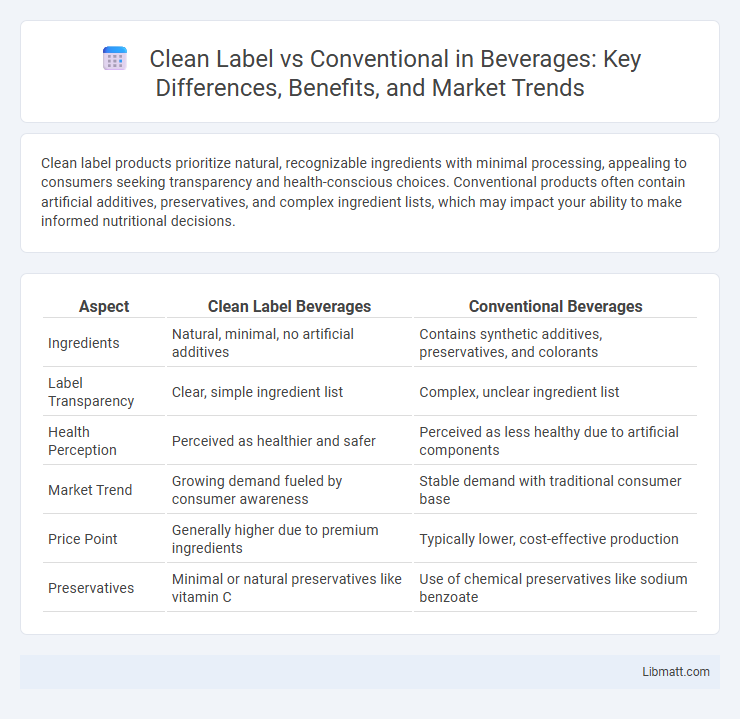Clean label products prioritize natural, recognizable ingredients with minimal processing, appealing to consumers seeking transparency and health-conscious choices. Conventional products often contain artificial additives, preservatives, and complex ingredient lists, which may impact your ability to make informed nutritional decisions.
Table of Comparison
| Aspect | Clean Label Beverages | Conventional Beverages |
|---|---|---|
| Ingredients | Natural, minimal, no artificial additives | Contains synthetic additives, preservatives, and colorants |
| Label Transparency | Clear, simple ingredient list | Complex, unclear ingredient list |
| Health Perception | Perceived as healthier and safer | Perceived as less healthy due to artificial components |
| Market Trend | Growing demand fueled by consumer awareness | Stable demand with traditional consumer base |
| Price Point | Generally higher due to premium ingredients | Typically lower, cost-effective production |
| Preservatives | Minimal or natural preservatives like vitamin C | Use of chemical preservatives like sodium benzoate |
Understanding Clean Label: Definition and Scope
Clean label products emphasize transparency, using simple, recognizable ingredients free from artificial additives, preservatives, and synthetic chemicals, appealing to health-conscious consumers. The clean label scope extends beyond just ingredient lists, encompassing ethical sourcing, minimal processing, and clear labeling to build consumer trust. Conventional products often contain complex chemical additives and preservatives aimed at prolonging shelf life or enhancing flavor but lack the straightforward ingredient transparency that defines clean label items.
Conventional Food Labels: Key Characteristics
Conventional food labels typically feature extensive ingredient lists, including artificial additives, preservatives, and synthetic chemicals, which can be difficult for consumers to interpret. These labels often emphasize nutritional facts like calories, fats, and sugars but may lack transparency about sourcing and processing methods. Understanding conventional food labels helps you make informed choices by identifying potentially unwanted ingredients and assessing overall product quality.
Ingredient Transparency: Clean Label vs Conventional
Ingredient transparency in clean label products emphasizes clear, simple, and recognizable ingredients, avoiding artificial additives and preservatives to build consumer trust. Conventional products often contain complex, synthetic components with limited disclosure, making it harder for consumers to identify each ingredient's source and purpose. This contrast highlights the growing demand for honesty and simplicity in food labeling, driving clean label popularity.
Consumer Trends Shaping Label Preferences
Consumer trends increasingly favor clean label products due to growing demand for transparency, natural ingredients, and minimal processing. Conventional labels often contain unfamiliar additives that consumers are actively avoiding to support healthier and more sustainable choices. Understanding these preferences helps your brand align product development with evolving market expectations.
Regulatory Differences Between Clean and Conventional Labels
Regulatory differences between clean label and conventional products primarily revolve around ingredient transparency and restrictions on synthetic additives. Clean label regulations emphasize clear, recognizable, and natural ingredient listings, often limiting artificial preservatives, colors, and flavors to meet consumer demand for simpler, safer products. Your choice of clean label items ensures compliance with stricter regulations aimed at promoting health-conscious and environmentally friendly food production standards.
Health Implications: Clean Label Ingredients
Clean label ingredients typically emphasize natural, minimally processed components, reducing exposure to artificial additives and preservatives linked to adverse health effects. Your diet benefits from clearer ingredient transparency, potentially lowering the risk of allergies, sensitivities, and chronic diseases associated with synthetic chemicals. Compared to conventional foods, clean label options often support improved digestive health and overall wellness by prioritizing whole, recognizable ingredients.
Cost Analysis: Clean Label vs Traditional Products
Clean label products often involve higher ingredient costs due to the use of natural, non-GMO, and minimally processed components, which can impact overall pricing compared to conventional products. Traditional products benefit from economies of scale and synthetic additives, reducing production expenses and offering lower retail prices. Your cost analysis should consider long-term consumer demand trends and potential premium pricing strategies for clean label options that justify the initial higher investment.
Challenges in Clean Label Product Development
Clean label product development faces challenges such as ingredient functionality, shelf life stability, and consumer expectations for transparency. Reformulating conventional products without synthetic additives requires innovation in natural preservatives and stabilizers to maintain quality and safety. You must balance clean label demands with regulatory compliance and supply chain constraints to ensure product success.
Industry Innovations Driving Clean Label Movement
Industry innovations driving the clean label movement include advancements in natural preservatives, plant-based ingredients, and transparent sourcing practices. These innovations enable manufacturers to replace synthetic additives with recognizable, minimally processed components that meet consumer demands for clean and simple foods. Your product development can leverage these trends to align with evolving market preferences and regulatory standards.
Future Outlook: Clean Label vs Conventional Products
Clean label products are projected to dominate the future food market due to increasing consumer demand for transparency, natural ingredients, and health-conscious options. Conventional products may face declining market share as regulatory pressures and consumer preferences shift toward sustainability and minimal processing. Innovation in clean label formulations, such as plant-based ingredients and allergen-free solutions, is driving growth and redefining product standards across the industry.
Clean label vs conventional Infographic

 libmatt.com
libmatt.com